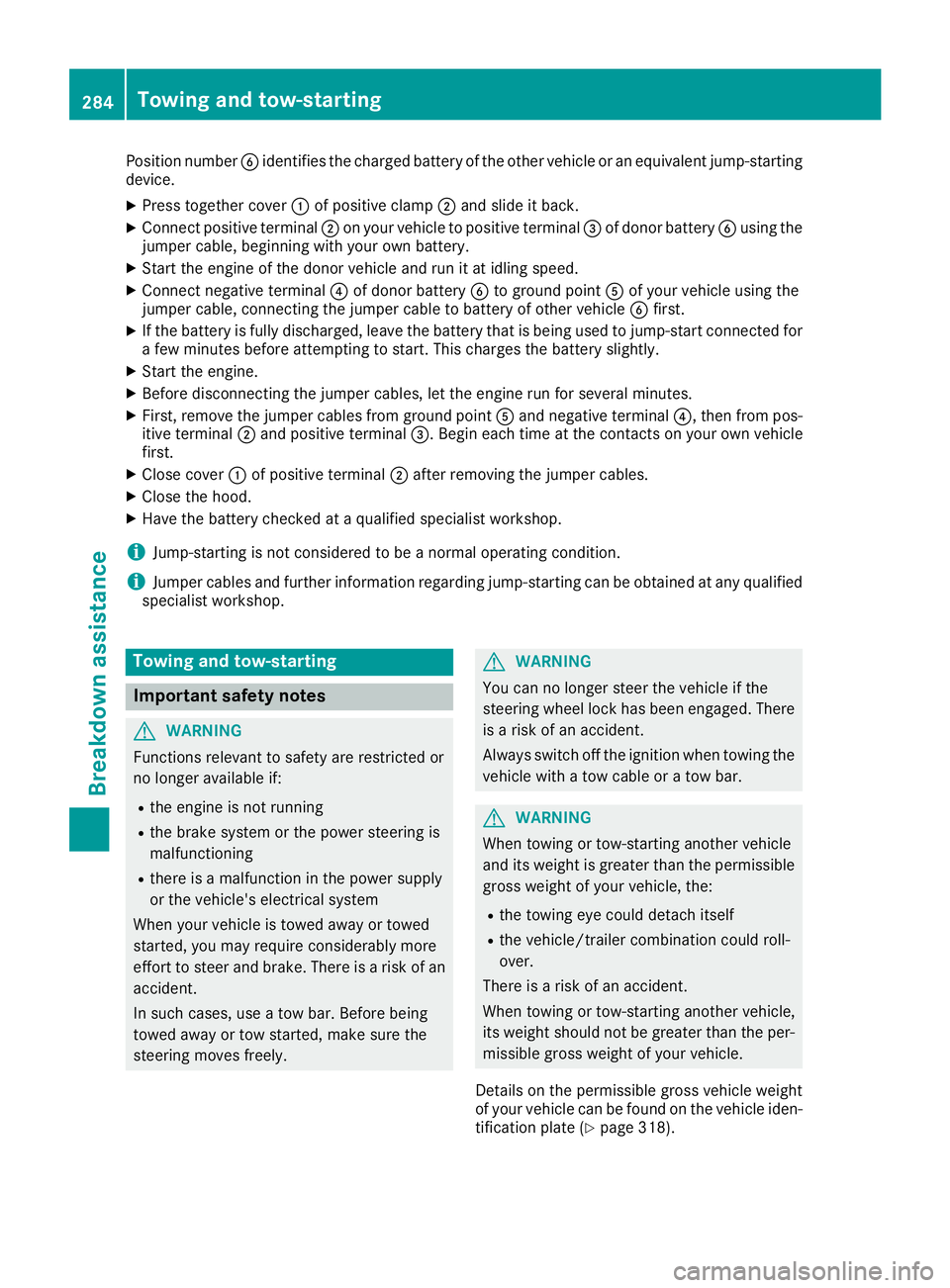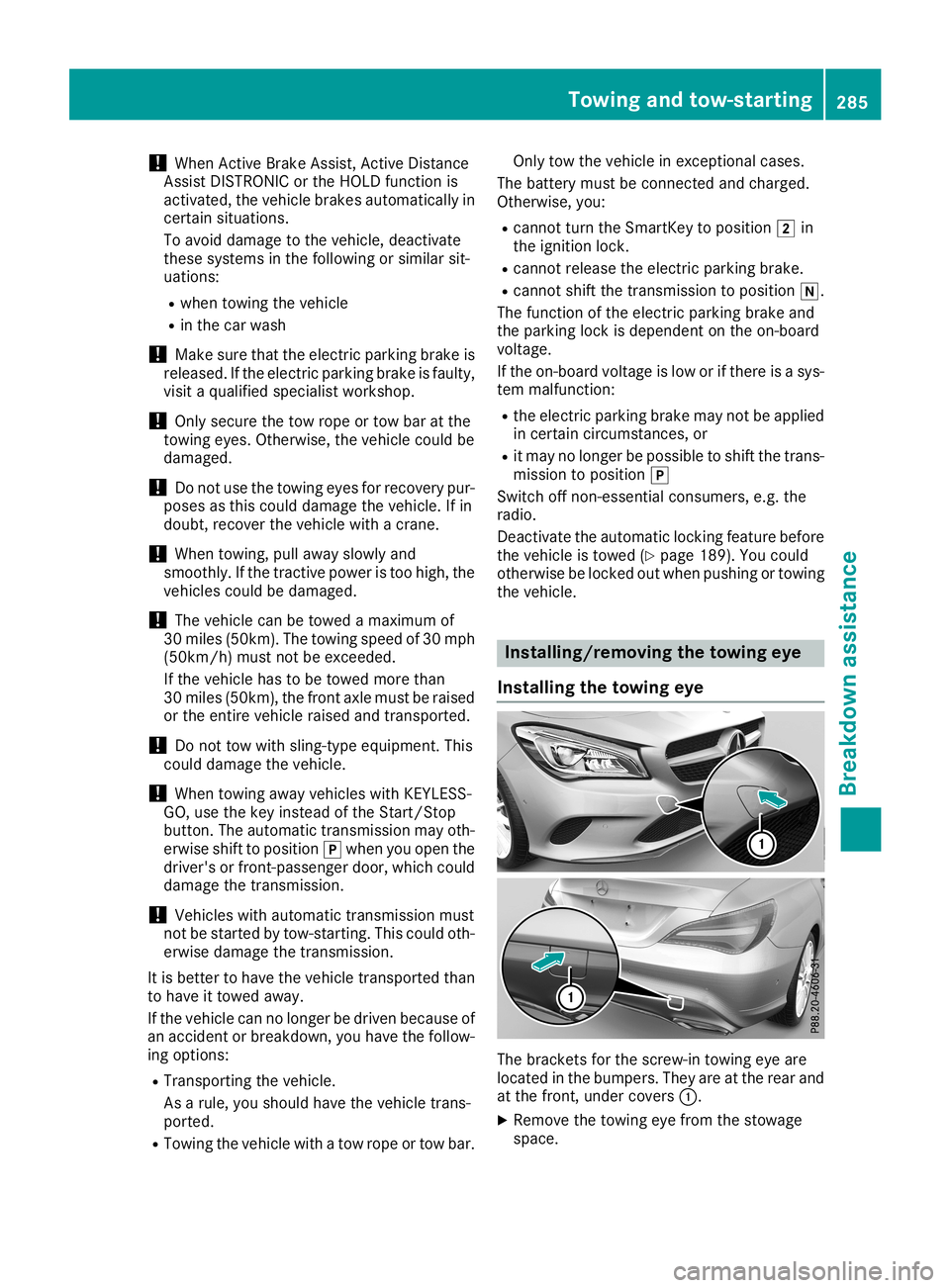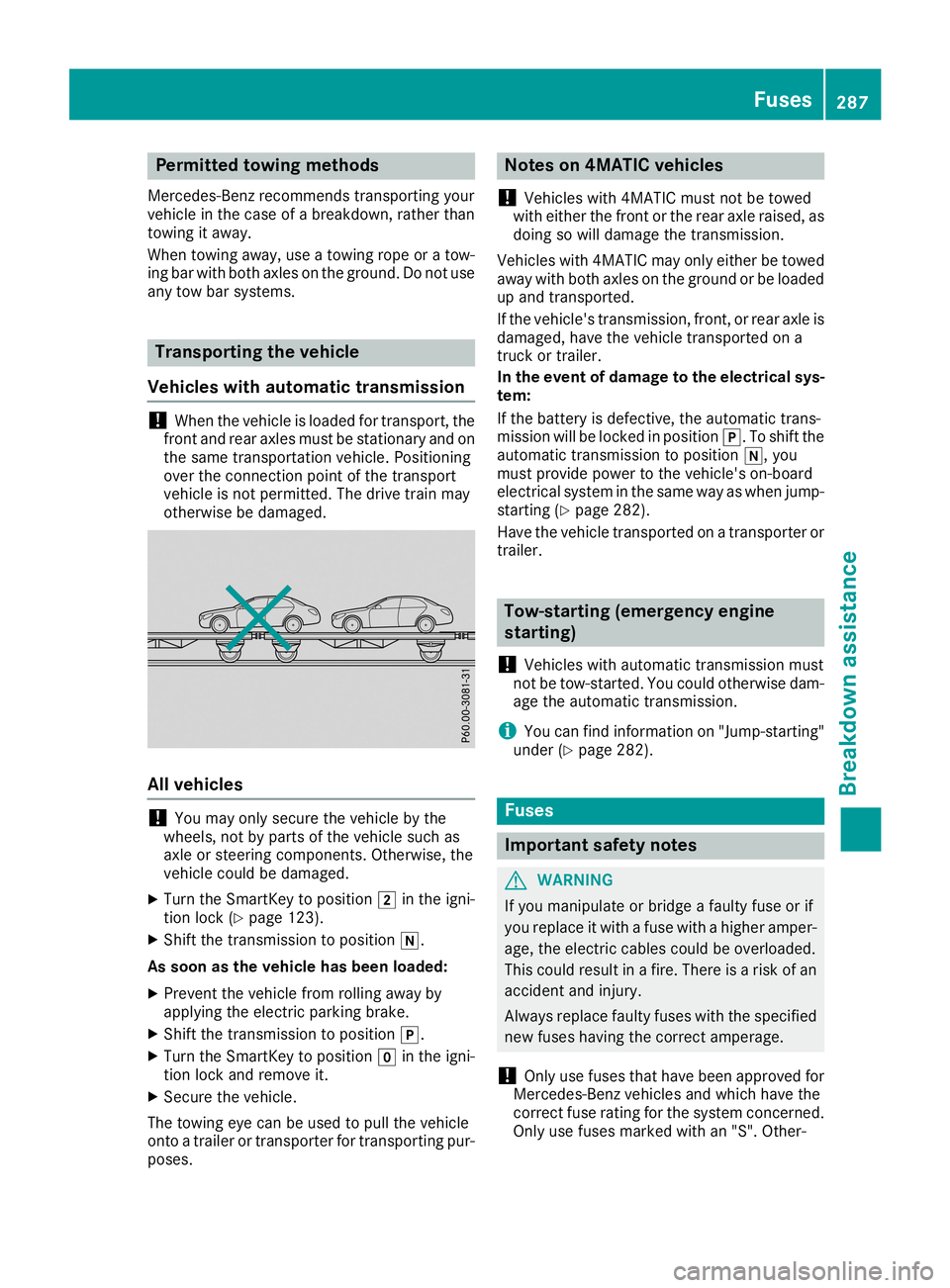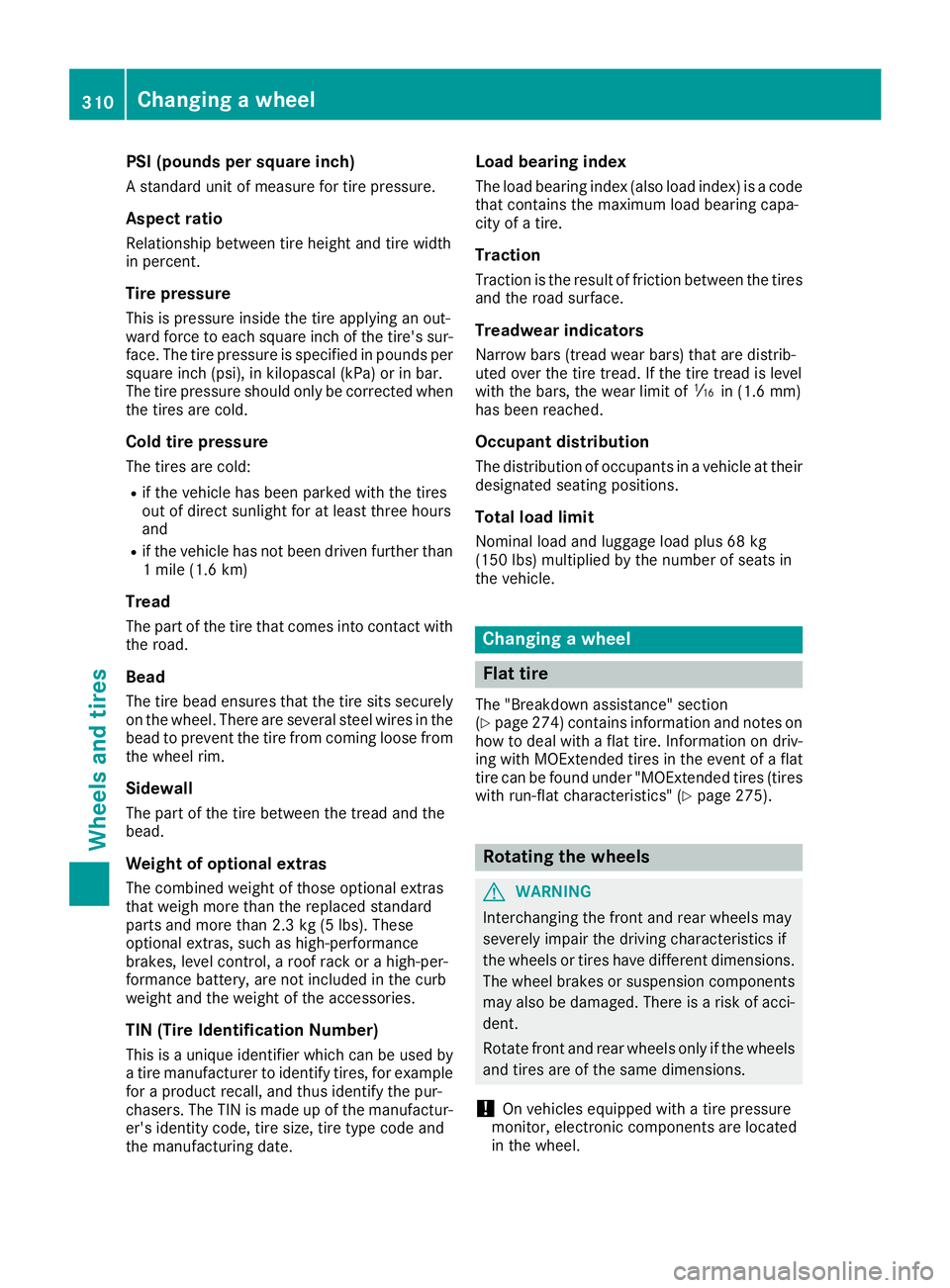2019 MERCEDES-BENZ CLA COUPE battery
[x] Cancel search: batteryPage 286 of 330

Position
number0084identifies thecharged batteryofthe other vehicle oran equivalent jump-starting
device.
X Press togethercover 0043ofpositive clamp0044and slide itback.
X Connec tpositive terminal0044 onyour vehicle topositive terminal0087 ofdonor battery 0084using the
jumper cable,beginnin gwith your ownbattery.
X Start theengine ofthe donor vehicle andrunitat idling speed.
X Connec tnegative terminal0085 ofdonor battery 0084toground point0083ofyour vehicle usingthe
jumper cable,connectin gthe jumper cabletobattery ofother vehicle 0084first.
X Ifthe battery isfully discharged, leavethebattery thatisbeing usedtojump-st artconn ected for
a few minutes beforeattemptingtostart .This charges thebattery slightly.
X Start theengine.
X Before disconn ectingthe jumper cables,letthe engine runforseveral minutes.
X First ,remove thejumper cablesfromground point0083and negative terminal0085, then from pos-
itive termin al0044 and positive terminal0087. Begin eachtimeatthe cont acts onyour ownvehicle
first.
X Close cover0043ofpositive terminal0044 after removin gthe jumper cables.
X Close thehood.
X Have thebattery checkedataqualified specialist workshop.
i Jump-start
ingisnot cons idered tobe anormal operating condition.
i Jumper
cablesandfurther informationregarding jump-startingcanbeobtained atany qualified
specialist workshop. Towing
andtow-sta rting Impor
tantsafety notes G
WARNIN
G
Funct ionsrelevant tosafety arerestr icted or
no longer availabl eif:
R the engine isnot runnin g
R the brake system orthe power steerin gis
malfunct ioning
R there isamalfunct ioninthe power supply
or the vehicle's electricalsystem
When yourvehicle istowed awayortowed
start ed,you may require considerably more
effort tosteer andbrake. Thereisarisk ofan
accident .
In such cases, useatow bar. Before being
towed awayortow start ed,make surethe
steerin gmoves freely. G
WARNIN
G
You cannolonger steerthevehicle ifthe
steerin gwheel lockhasbeen engaged. There
is arisk ofan accident .
Always switchoffthe ignition whentowing the
vehicle withatow cable oratow bar. G
WARNIN
G
When towing ortow-st arting another vehicle
and itsweight isgreater thanthepermissible
gross weight ofyour vehicle, the:
R the towing eyecould detach itself
R the vehicle/t railercombinat ioncould roll-
over.
There isarisk ofan accident .
When towing ortow-st arting another vehicle,
its weight should notbegreater thantheper-
missible grossweight ofyour vehicle.
Det ails onthe permissible grossvehicle weight
of your vehicle canbefound onthe vehicle iden-
tificat ionplate (Ypage 318). 284
Towing
andtow-sta rtingBr eakdown assistance
Page 287 of 330

!
When
Active Brake Assist, Active Distance
Assist DISTRONIC orthe HOLD function is
activated, thevehicle brakesautomaticall yin
certain situations.
To avoid damage tothe vehicle, deactivate
these systems inthe followi ngorsimila rsit-
uations:
R when towing thevehicle
R in the carwash
! Make
surethattheelectric parking brakeis
released .If the electric parking brakeisfaulty,
visit aqual ified speciali stworkshop.
! Only
secure thetow rope ortow baratthe
towing eyes.Otherwise, thevehicle couldbe
damage d.
! Do
not use thetowing eyesforrecovery pur-
poses asthis could damage thevehicle. Ifin
doubt, recover thevehicle withacrane.
! When
towing, pullawayslowly and
smoothly. Ifthe tractive poweristoo high, the
vehicles couldbedamage d.
! The
vehicle canbetowed amaximum of
30 miles (50km). Thetowing speedof30 mph
(50km/h) mustnotbeexceeded.
If the vehicle hastobe towed morethan
30 miles (50km), thefront axlemust beraised
or the entire vehicle raisedandtransported.
! Do
not tow with sling-type equipment. This
could damage thevehicle.
! When
towing awayvehicles withKEYLES S-
GO, usethekey instead ofthe Start/ Stop
button. Theautomatic transmission mayoth-
erwise shifttoposition 005Dwhen youopen the
driver's orfront -passenger door,which could
damage thetransmission.
! Vehicles
withautomatic transmission must
not bestarted bytow-start ing.This could oth-
erwise damage thetransmission.
It is better tohave thevehicle transported than
to have ittowed away.
If the vehicle cannolonger bedriven because of
an accident orbreakdown, youhave thefollow-
ing options:
R Transporting thevehicle.
As arule, youshould havethevehicle trans-
ported.
R Towing thevehicle withatow rope ortow bar. Only
towthevehicle inexceptional cases.
The battery mustbeconnec tedand charged.
Otherwise, you:
R cannot turntheSmartKey toposition 0048in
the ignition lock.
R cannot release theelectric parking brake.
R cannot shiftthetransmission toposition 005C.
The function ofthe electric parking brakeand
the parking lockisdependent onthe on-board
voltage.
If the on-board voltageislow orifthere isasys-
tem malfunction:
R the electric parking brakemaynotbeappli ed
in certain circumstances, or
R itmay nolonger bepossible toshift thetrans-
mission toposition 005D
Switch offnon- essential consumers, e.g.the
radio.
Deactivate theautomatic lockingfeaturebefore
the vehicle istowed (Ypage 189). Youcould
otherwise belocked outwhen pushing ortowing
the vehicle. Installin
g/removing thetowing eye
Installin gthe towing eye The
brackets forthe screw-in towingeyeare
located inthe bumpers. Theyareatthe rear and
at the front ,under covers 0043.
X Remove thetowing eyefrom thestowage
space. Towing
andtow-start ing
285Breakdown assistance Z
Page 289 of 330

Permit
tedtowing method s
Mercedes-B enzrecommen dstransport ingyour
vehicle inthe case ofabreakdown, ratherthan
towing itaway .
When towing away,use atowing ropeoratow-
ing bar with both axles onthe ground. Donot use
any tow barsystems. Tr
ansport ingthe vehicle
Vehicles withautom atictransmission !
When
thevehicle isloaded fortransport ,the
front andrear axles mustbestationary andon
the same transport ationvehicle. Positioning
over theconn ection pointofthe transport
vehicle isnot permitted. Thedrive trainmay
otherwise bedamaged. All
vehicle s !
You
may onlysecure thevehicle bythe
wheels, notbyparts ofthe vehicle suchas
axle orsteering componen ts.Otherwise, the
vehicle couldbedamaged.
X Turn theSmartK eytoposition 0048inthe igni-
tion lock (Ypage 123).
X Shift thetransm issiontoposition 005C.
As soon asthe vehicle hasbeen loaded:
X Prevent thevehicle fromrolling awayby
apply ingthe electric parking brake.
X Shift thetransm issiontoposition 005D.
X Turn theSmartK eytoposition 005Ainthe igni-
tion lock andremove it.
X Secure thevehicle.
The towing eyecan beused topull thevehicle
onto atrailer ortransport erfor transport ingpur-
poses. Notes
on4MATIC vehicles
! Vehicles
with4MATIC mustnotbetowed
with either thefront orthe rear axle raised, as
doing sowill damage thetransm ission.
Vehicles with4MATIC mayonlyeither betowed
away withboth axles onthe ground orbe loaded
up and transport ed.
If the vehicle's transmission,front,or rear axle is
damaged, havethevehicle transport edon a
truck ortrailer.
In the event ofdam agetothe elec trical sys-
tem:
If the battery isdefective, theautomatic trans-
mission willbelocked inposition 005D.Toshift the
automatic transmissiontoposition 005C,you
must provide powertothe vehicle's on-board
electrical systeminthe same wayaswhen jump-
startin g(Y page 282).
Have thevehicle transport edon atransport eror
trailer. Tow-star
ting(emergency engine
star ting)
! Vehicles
withautomatic transmissionmust
not betow-st arted. Youcould otherwise dam-
age theautomatic transmission.
i You
canfind information on"Jump-starting"
under (Ypage 282). Fuses
Import
antsafety notes G
WARNING
If you manipulate orbridge afaulty fuseorif
you replace itwith afuse withahigher amper-
age, theelectric cablescouldbeoverloaded.
This could result inafire. There isarisk ofan
accident andinjury.
Always replace faultyfuseswiththespecified
new fuses having thecorrect amperage.
! Only
usefuses thathave been approved for
Mercedes-B enzvehicles andwhich havethe
correct fuserating forthe system concerned.
Only usefuses marked withan"S". Other- Fuses
287Breakdown assistance Z
Page 312 of 330

PSI
(pounds persquar einch)
A standard unitofmeasure fortire pressure.
Aspect ratio
Relationship betweentireheight andtirewidth
in percent .
Tire pressur e
This ispressure insidethetire apply inganout-
ward force toeach square inchofthe tire's sur-
face. Thetirepressure isspecified inpounds per
square inch(psi), inkilopascal (kPa)orinbar.
The tirepressure shouldonlybecorrect edwhen
the tires arecold.
Cold tirepressur e
The tires arecold:
R ifthe vehicle hasbeen parked withthetires
out ofdirect sunlight foratleast three hours
and
R ifthe vehicle hasnotbeen driven further than
1 mile (1.6km)
Tread
The part ofthe tire that comes intocont actwith
the road.
Bead The tirebead ensures thatthetire sits securely
on the wheel. Thereareseveral steelwires inthe
bead toprevent thetire from coming loosefrom
the wheel rim.
Sidewall The part ofthe tire between thetread andthe
bead.
Weight ofoptional extras
The combined weightofthose optional extras
that weigh morethanthereplaced standard
parts andmore than2.3kg(5lbs). These
optional extras,such ashigh-performanc e
brakes, levelcontrol,aroof rack orahigh-per-
formanc ebattery, arenot included inthe curb
weight andtheweight ofthe accessories.
TIN (Tire Identification Number)
This isaunique identifier whichcanbeused by
a tire manufacturer toidentify tires,forexample
for aproduct recall,andthus identify thepur-
chasers. TheTINismade upofthe manufactur-
er's identity code,tiresize, tiretype code and
the manufacturing date. Load
bearing index
The load bearing index(alsoloadindex) isacode
that contains themaximum loadbearing capa-
city ofatire.
Tra ction
Traction isthe result offrict ionbetween thetires
and theroad surface.
Tread wearindicators
Narrow bars(tread wearbars) thataredistrib-
uted overthetire tread. Ifthe tire tread islevel
with thebars, thewear limitof00CD in(1.6 mm)
has been reached.
Occupant distribution
The distribution ofoccupants inavehicle attheir
designated seatingpositions.
Total loadlimit
Nominal loadandluggage loadplus68kg
(15 0lbs )multiplied bythe number ofseats in
the vehicle. Changing
awheel Flat
tire
The "Breakdown assistance"section
(Y page 274)contains information andnotes on
how todeal with aflat tire. Inform ationondriv-
ing with MOExt ended tiresinthe event ofaflat
tire can befound under "MOExt endedtires(tires
with run-flat characterist ics"(Ypage 275). Rotat
ingthe wheels G
WARNING
Int erchanging thefront andrear wheels may
severely impairthedriving characterist icsif
the wheels ortires have different dimensions.
The wheel brakes orsuspension components
may alsobedamaged. Thereisarisk ofacci-
dent.
Rotate frontandrear wheels onlyifthe wheels
and tires areofthe same dimensions.
! On
vehicles equippedwith atire pressure
monitor ,electron iccomponen tsare located
in the wheel. 310
Changing
awheelWheels andtires